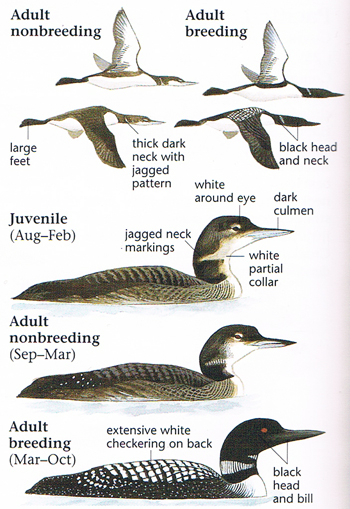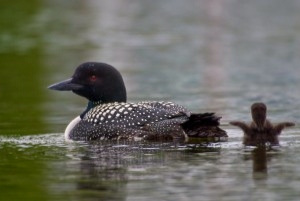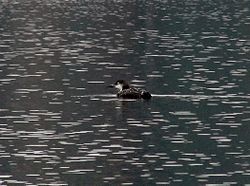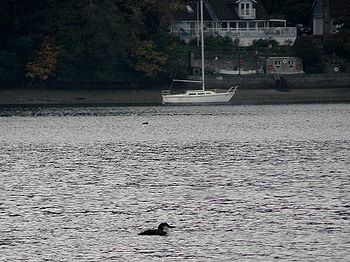Common Loon
From marinelife1011
| Gavia immer | |
|---|---|
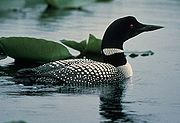 |
|
| Common Loon in adult breeding colors, Anacortes Washington. | |
| Scientific classification | |
| Kingdom: | Animalia |
| Phylum: | Chordata |
| Class: | Aves |
| Order: | Gaviiformes |
| Family: | Gaviidae |
| Genus: | Gavia |
| Species: | G.immer |
| Binomial name | |
| Gavia immer (Brunnich, 1764) |
|
Gavia immer
The Common Loon has a long, and mystical connection to the waters of the Northwest and across the Globe. These birds carry a deep connection with Native American mythology, and were known in "the Old World" as the “Great Northern Diver” due to their amazing capabilities at pursuit of prey beneath the water. The word Gavia is Latin for Smew, a sea duck not related to the Common Loon. The word immer is Northern Germanic for the grey/blackened ashes of a fire, referring to the dark plumage. The Common Loon has been described many times as a true master of the Aquatic environment.
Contents |
Description
Morphology
Both Sexes
Length: 26–36 in (66–92 cm) Wingspan 41–58 in (104–147 cm) Weight 1.6-8kg (3.5-18lbs)
G.immer is a large, heavier bodied bird that rides low in the water and has striking, deep red eyes with a distinctive call. Sexual dimorphism is very minimal in this species. Males tend to appear bigger than females, however sexes are indistinguishable by plumage alone, especially from afar. The feet are large, webbed, and located to the far back of the body. They move in a sweeping motion from side to side, rather than forward like most birds. These adaptations of the feet and their movement allow for much more efficient swimming, however walking on land is very difficult and partially the reason for G.immer being called a “Loon” due to their silly appearance when attempting to walk on land. (McIntyre, J. W. and J. F. Barr. 1997.)
The Plumage of this species is quite distinct. The entire head and neck of breeding adult Loons are sooty black with a slight green gloss near the base of the neck. The back, sides and wings are also sooty black with white spotting and checkering along the back. Used as a distinctive marking for field identification, the scapulars and wing-coverts of this species have large white markings. The Common Loon has two patches of vertical white striping located on the side and upper foreneck. The breast and belly are all white. The bill is straight and pointed with sharp, rearward-pointing sharp denticles located inside the roof of the mouth and on the tongue to help with retention of slippery prey. (McIntyre, J. W. 1988.; The Birds of North America Online)
Non-breeding coloration is a pale grey-brown head, neck, and body. They have white on their face, neck, and underside with white eye rings.
Juveniles, carry almost the same plumage as the adult non-breeding colors, however they tend to have a paler bill with white scalloping on their back. (USGS: Common Loon)
Similar species
There are several species of Loon, in particular the Yellow-Billed Loon and Pacific Loon that often are mistaken for the Common Loon due to similar markings, body shape, size, and call. Each Loon species has a distinctly different appearance, however looking from a distance with an untrained eye can make it easy to mistake one species for another. Other Loon species as well as Grebes, and Mergansers can superficially resemble the appearance of the Common Loon making public sightings be actual misidentification rather than a true sighting. This can be of concern for researchers depending on accurate reporting from other regions of the state or country. (Richardson, S. et al. 2000)
List of similar species: 1. Yellow-Billed Loon (Gavia adamsii) 2. Pacific Loon (Gavia pacifica) 3. Red-Throated Loon (Gavia stellata) 4. Common Merganser (Mergus merganser) 5. Red-Necked Grebes (Podiceps grisegena)
Natural History
Migration
Most Common Loons seen in Washington state are traveling between the areas of Canada, Alaska, and the Northern Tier States of the United States. These are the primary locations that G.immer uses for breeding habitats. Adult male loons begin their Northern migration most often before the females in order to establish a breeding territory. The males maintain and defend their nesting sites from other pairs of Loons and are very aggressive during the breeding season. The males will start their migrations in late March-early April.(Richardson, S. et al. 2000.; McIntyre and Barr 1997). Common Loons primary migration movement happens in mid-late April and can extend into early May. (Richardson, S. et al. 2000.) Young loons migrate to breeding waters at a later time that the adults, usually around June. (McIntyre and Barr 1997). Juvenile Common Loons often stay in their marine environment throughout the summer rather than migrating at all. (Richardson, S. et al. 2000.)
Post-breeding, Common Loons will return to their Marine locations usually around late August, and it will continue through till November. (Richardson, S. et al. 2000.) Some individuals and even small groups of loons will spend winter at inland locations on large bodies of fresh water habitat rather than only marine areas.
Reproduction
G.immer has their nesting season during the months of April-September. (Hamer Environmental.2003.) The mated pairs are very territorial during the breeding season from any other species of animal. The ideal nesting locations are floating debris, and islands, however shoreline nesting is the most common. Nesting begins usually within the first 2-3 weeks after the migration to the breeding grounds. Multiple conditions determine the exact time frame for laying such as weather conditions, fluctuating water levels is a huge hindrance in reservoir habitats, and most of all finding a suitable mate. Normally the Common Loon lays two eggs and both parents will incubate the eggs. (Bird Web-Seattle Audubon Society) The incubation period lasts approximatively 28-30 days before the chick will hatch. The majority of the babies are born around late May into June. (Hamer Environmental.2003.) Asynchronous hatching is common among G.immer and is thought to be a strategy developed due to varying food availability. The chicks will be ready to leave the nest within 2-3 days and are fully capable of swimming, diving, and hunting. The chicks will rest on the backs of their parents once the nest has been abandoned. If a clutch is lost for any reason, and it is early enough within the mating season, the pair will re-lay. (Hamer Environmental.2003.)
Feeding
The Common Loon mostly consumes small fish, however they will also hunt aquatic plants and insects, crustaceans, worms, and even leeches. (South Dakota Birds)
Vocalizations
The Common loon is known to have four basic calls each relevant to different behaviors. (McIntyre and Barr 1997).
1. The Yodel is only given by the males, and each call is unique to that male. This call is also a territorial signal and is sometimes seen as the male loon’s “song”. (McIntyre, J. W. 1988.)
2. The Hoot is seen as a method of identification for contact, and is a lower tone with short length.
3. The Wail tends to be longer with clear notes and are used many times as an invitation of interaction and is the haunting call the loons have become so known for. This call also serves as a way of identifying where other loons are on the water. It is often heard in the early evening and into the night as a method of vocal location between the loons. (McIntyre, J. W. 1988.)
4. The Tremolo is most often called a “laughing call”, and indicates danger/fear. This call is also most often used as an identifier of this species due to frequent unintentional human intrusion on their habitat. (McIntyre, J. W. and J. F. Barr. 1997.) The Tremelo is often heard if there is potential risk to the nest/chick, and if the Loon is fleeing a predator. (Journey North Loon Migration)
Ecology
Habitat
The Common Loon is an open water species that you will find in many different marine environments during the winter. They are most often in salt water locations fairly shallow in depth and near to shore, however they can be occasionally found in fresh water locations during the winter months. During their breeding season they utilize large bodies of water heavily forested with sloping shorelines, bays, inlets and multiple islands. Floating woody debris and grass islands are ideal nesting platforms for the Common Loon. They need locations that have abundant food supply during their breeding season and the bodies of water themselves have to be large to supply enough space for loons to take off or land. Common Loons have been successful in utilizing artificial sites for nesting. (Hamer Environmental.2003.)
Geographic range
During the migration Common Loons are found in high numbers along Puget Sound, Hood Canal, and Willipa Bay. (Richardson, S. et al. 2000.) Eastern Washington during migration, will have some decent counts on larger bodies of fresh water, and have small groups or individuals during the winter months as well. According to the Seattle Audubon Society-Bird Web, Common Loons have been found nesting in Okanogan, Douglas, Chelan, Whatcom, and King Counties. Juvenile loons can be found scatter among all the described habitats. The general region that Common Loons have been depicted using for breeding covers habitat in Alaska, Canada, and most of the Northern Tier States. They do still range over a large portion of the west coast over the winter months from the northern Aleutians to Mexico.(Hamer Environmental.2003.)

Abundance
The Global population estimates of the common loon, are approximatively 500,000-750,000 birds. (McIntyre, J. W. and J. F. Barr. 1997.)They are considered to be a common found species and low risk, however they are carefully monitored due to potential decline in numbers caused by their sensitive breeding behaviors. According to The Birds of North America Online, "North America's winter range of the Common Loon along the Pacific Coast populations likely encompass breeding populations from Montana, Saskatchewan, western Nunavut, and Northwest Territories, west to the Coast. Based on the estimated number of breeding loons and information on migratory movements, approximately 215,000 to 221,000 loons (184,000 to 189,000 adults and 31,000 to 32,000 juveniles) comprising 30% of the total population over-winter on the Pacific Coast." Over 94% of the breeding populations of loons are found within Canada. (The Birds of North America Online)
Conservation
There are several principal threats described repeatedly. These concerns are habitat loss, degradation from development, human influences on water levels, human disturbance from boating and fishing, entanglement due to fishing lines, and Lead poisoning. Mortality from ingesting fishing equipment is a leading cause of death for these birds. They get exposed by eating small fish and through the ingestion of these fish with hooks, weights, or other fishing gear stuck on/inside the fish, they are thus contaminated and most often killed. Other potential threats include toxins, disease, oil spills, and predation. Washington State Loon nesting concerns stem from the issues/problems surrounding shoreline development, the fluctuation of the water levels, and basic human disturbance. (Hamer Environmental.2003.; Richardson, S. et al. 2000.)
References
External Links
Informative Video
Detailed video/audio description of the Common Loon provided by The Cornell Lab of Ornithology courtesy of Macaulay Library: [1]
Descriptive video with beautiful photography of the Common Loon. [2]
Websites
1. All About Birds: http://www.allaboutbirds.org/guide/common_loon/id
2. Bird Web-Seattle Audubon Society: http://www.seattleaudubon.org/birdweb/bird_details.aspx?value=search&id=4
3. Common Loon, Journey North: http://www.learner.org/jnorth/search/LoonNotes1.html
4. Cornell Lab of Ornithology: http://www.birds.cornell.edu/Page.aspx?pid=1478
5. E.Nature.com: http://www.enature.com/fieldguides/detail.asp?allSpecies=y&searchText=common%20loon&curGroupID=1&lgfromWhere=&curPageNum=1
6. Journey North Loon Migration: http://www.learner.org/jnorth/search/LoonNotes1.html
7. Mt.gov-Montana Field Guides: http://fieldguide.mt.gov/detail_ABNBA01030.aspx
8. National Geographic: http://animals.nationalgeographic.com/animals/birds/common-loon/
9. South Dakota Birds: http://sdakotabirds.com/species/common_loon_info.html
10. The Birds of North America Online: http://bna.birds.cornell.edu/bna/species/313/articles/characteristics
11. USGS ID Info: http://www.mbr-pwrc.usgs.gov/id/framlst/i0070id.html
12. What Bird.com: http://identify.whatbird.com/obj/67/_/Common_Loon.aspx
13. Wikipedia: http://en.wikipedia.org/wiki/Loon
Resources
1. Good, T.P. et al. 2009. Ghosts of the Salish Sea: Threats to Marine Birds in Puget Sound and the Northwest Straits from Derelict Fishing Gear. Marine Ornithology 37: 67–76 http://www.marineornithology.org/PDF/37_1/37_1_67-76.pdf
2. Hamer Environmental.2003.Analysis Species Assessment: Common Loon (Gavia immer).FERC Project No.2150.Puget Sound Energy
3. McIntyre, J. W. 1988. The common loon: spirit of northern lakes. Univ. Minnesota Press.
4. McIntyre, J. W. and J. F. Barr. 1997. Common Loon (Gavia immer). In The Birds of North America, No. 313 (A. Poole and F. Gill, eds.). The Academy of Natural Sciences, Philadelphia, PA, and The American Ornithologists' Union
5. Read, M.2008.Living Bird Magazine, Spring Edition: Spirit of the North.Cornell Laboratory of Ornithology
6. Richardson, S. et al. 2000. Washington state status report for the
7. Common Loon. Washington Department of Fish and Wildlife, Olympia. 53 pp. http://wdfw.wa.gov/publications/00341/wdfw00341.pdf
8. Sibley, D.A.2003.The Sibley Field Guide to Birds of Western North America.Alfred A. Knopf.
9. Sibley, D.A.2001.The Sibley Field Guide to Bird Life & Behavior.Alfred A. Knopf.
10. Strong, P.1995.Call of the Loon (Camp and Cottage). North Word Press
Photography
1. Anacortes Properties and Investments- Photographer Unknown, no listed copyright: Common Loon adult breeding colors, Anacortes Washington http://www.anacortespi.com/anacortes.cfm
2. JTRealty Conway Lake Blog-Photographer Uknown-Conway Lake Loon Count, no listed copyright: Adult loon swimming with baby, Photo taken June 30th, 2009 http://blog.jtrealty.com/lakeside-living/conway-lake-loon-count-june-30th-2009/
3. Photograph by Erika Parton, Permission to use on this webpage-Common Loon in Winter plumage off of the Evergreen State College Beach. Dec.2011
4. Photograph by Erika Parton, Permission to use on this webpage-Common Loon in Eld Inlet Dec.2011
5. Photograph by Lisa Adulghani, Permission to use on this webpage-Common Loon in winter colors, Budd Inlet Feb.2011
6. The Sibley Field Guide to Birds of Western North America by David Allen Sibley-ID page on the Common Loon.
